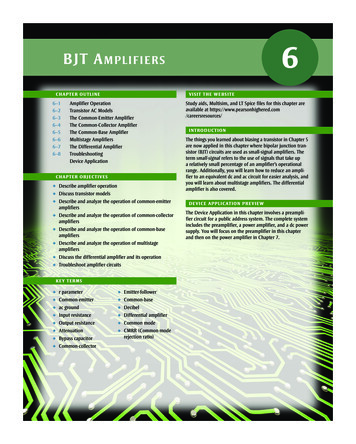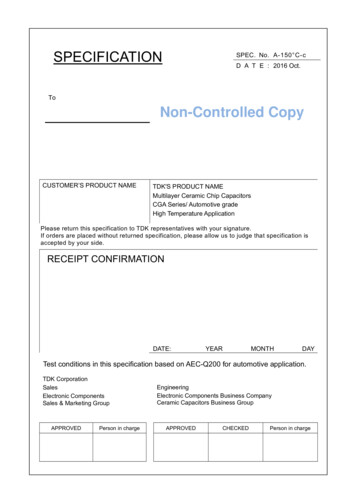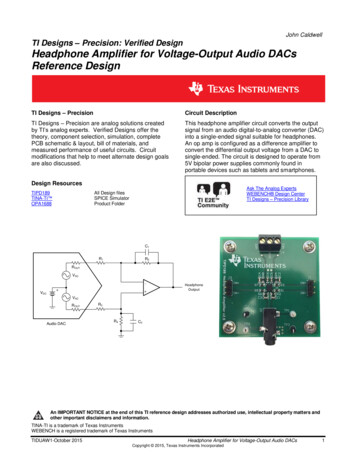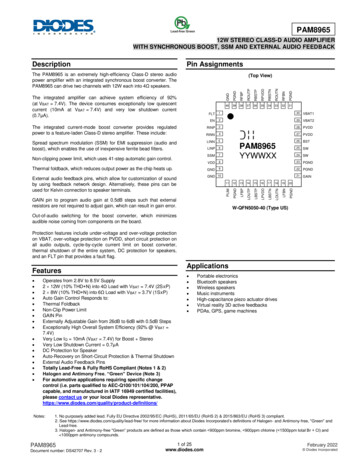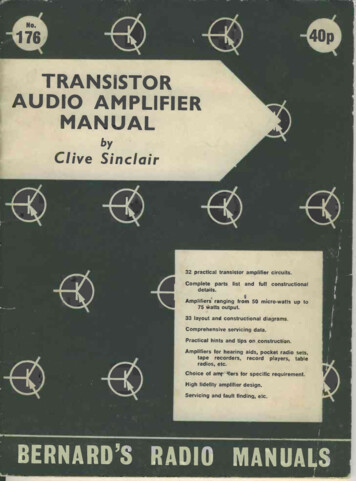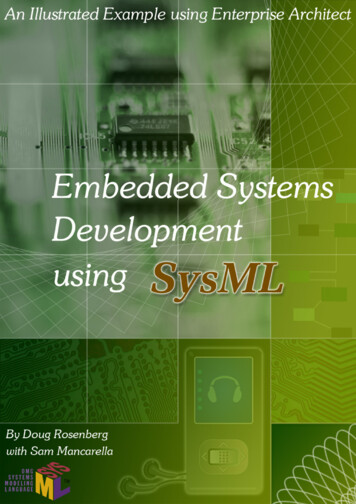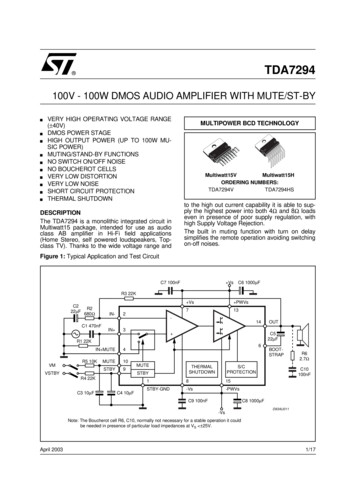
Transcription
TDA7294 100V - 100W DMOS AUDIO AMPLIFIER WITH MUTE/ST-BYVERY HIGH OPERATING VOLTAGE RANGE( 40V)DMOS POWER STAGEHIGH OUTPUT POWER (UP TO 100W MUSIC POWER)MUTING/STAND-BY FUNCTIONSNO SWITCH ON/OFF NOISENO BOUCHEROT CELLSVERY LOW DISTORTIONVERY LOW NOISESHORT CIRCUIT PROTECTIONTHERMAL SHUTDOWNDESCRIPTIONThe TDA7294 is a monolithic integrated circuit inMultiwatt15 package, intended for use as audioclass AB amplifier in Hi-Fi field applications(Home Stereo, self powered loudspeakers, Topclass TV). Thanks to the wide voltage range andMULTIPOWER BCD TECHNOLOGYMultiwatt15VMultiwatt15HORDERING NUMBERS:TDA7294VTDA7294HSto the high out current capability it is able to supply the highest power into both 4Ω and 8Ω loadseven in presence of poor supply regulation, withhigh Supply Voltage Rejection.The built in muting function with turn on delaysimplifies the remote operation avoiding switchingon-off noises.Figure 1: Typical Application and Test CircuitC7 100nF VsC6 1000µFR3 22KC222µFR2680ΩIN-2IN 3IN MUTE4C1 470nF Vs PWVs713-14C522µF R1 22KVMR5 10KVSTBYMUTE10STBY9R4 22KC3 10µFC4 TION1815STBY-GND-Vs-PWVsC9 100nFR62.7ΩC10100nFC8 1000µFD93AU011-VsNote: The Boucherot cell R6, C10, normally not necessary for a stable operation it couldbe needed in presence of particular load impedances at VS 25V.April 20031/17
TDA7294PIN CONNECTION (Top view)TAB connected to -VSBLOCK DIAGRAMABSOLUTE MAXIMUM RATINGSSymbolValueUnitSupply Voltage (No Signal) 50VIOPtotOutput Peak CurrentPower Dissipation Tcase 70 C1050AW0 to 70150 C CTopTstg, Tj2/17ParameterVSOperating Ambient Temperature RangeStorage and Junction Temperature
TDA7294THERMAL DATASymbolRth j-caseDescriptionThermal Resistance Junction-caseValueUnit1.5 C/WMaxELECTRICAL CHARACTERISTICS (Refer to the Test Circuit VS 35V, RL 8Ω, GV 30dB;Rg 50 Ω; Tamb 25 C, f 1 kHz; unless otherwise specified.SymbolParameterVSIqSupply RangeQuiescent CurrentIbTest ConditionMin.Typ.Max.Unit 102030 4065VmAInput Bias Current500nAVOSInput Offset Voltage 10mVIOSInput Offset Current 100nAPORMS Continuous Output Powerdd 0.5%:VS 35V, RL 8ΩVS 31V, RL 6ΩVS 27V, RL 4ΩMusic Power (RMS)IEC268.3 RULES - t 1s (*)d 10%RL 8Ω ; VS 38VRL 6Ω ; VS 33VRL 4Ω ; VS 29V (***)Total Harmonic Distortion (**)PO 5W; f 1kHzPO 0.1 to 50W; f 20Hz to 20kHz606060Slew RateGVOpen Loop Voltage GainGVClosed Loop Voltage GaineNTotal Input Noise100100100WWW0.10.01724A curvef 20Hz to 20kHzFrequency Response (-3dB)PO 1WRiSVRInput ResistanceSupply Voltage Rejectionf 100Hz; Vripple 0.5Vrms%%0.1%%V/µs3040dB125µVµV1080fL, fHTSWWW0.005VS 27V, RL 4Ω:PO 5W; f 1kHzPO 0.1 to 50W; f 20Hz to 20kHzSR707070dB20Hz to 20kHz10060Thermal ShutdownkΩ75dB145 CSTAND-BY FUNCTION (Ref: -VS or GND)VST onStand-by on ThresholdVST offATTst-byStand-by off ThresholdStand-by Attenuation1.53.570Quiescent Current @ Stand-byIq st-byMUTE FUNCTION (Ref: -VS or GND)VMonMute on ThresholdVMoffMute off Threshold3.5Mute AttenuatIon60ATTmuteVdB901V3mA1.5VV80dBNote (*):MUSIC POWER CONCEPTMUSIC POWER is the maximal power which the amplifier is capable of producing across the rated load resistance (regardless of non linearity)1 sec after the application of a sinusoidal input signal of frequency 1KHz.Note (**): Tested with optimized Application Board (see fig. 2)Note (***): Limited by the max. allowable current.3/17
TDA7294Figure 2: P.C.B. and components layout of the circuit of figure 1. (1:1 scale)Note:The Stand-by and Mute functions can be referred either to GND or -VS.On the P.C.B. is possible to set both the configuration through the jumper J1.4/17
TDA7294APPLICATION SUGGESTIONS (see Test and Application Circuits of the Fig. 1)The recommended values of the external components are those shown on the application circuit of Figure 1. Different values can be used; the following table can help the designer.LARGER THANSUGGESTEDSMALLER THANSUGGESTEDINCREASE INPUTIMPRDANCEDECREASE INPUTIMPEDANCECOMPONENTSSUGGESTED VALUEPURPOSER1 (*)22kINPUT RESISTANCER2680ΩR3 (*)22kR422kST-BY TIMECONSTANTLARGER ST-BYON/OFF TIMESMALLER ST-BYON/OFF TIME;POP NOISER510kMUTE TIMECONSTANTLARGER MUTEON/OFF TIMESMALLER MUTEON/OFF TIMEC10.47µFINPUT DCDECOUPLINGHIGHER LOWFREQUENCYCUTOFFC222µFFEEDBACK DCDECOUPLINGHIGHER LOWFREQUENCYCUTOFFC310µFMUTE TIMECONSTANTLARGER MUTEON/OFF TIMESMALLER MUTEON/OFF TIMEC410µFST-BY TIMECONSTANTLARGER ST-BYON/OFF TIMESMALLER ST-BYON/OFF TIME;POP NOISEC522µFBOOTSTRAPPINGSIGNALDEGRADATION ATLOW FREQUENCYC6, C81000µFSUPPLY VOLTAGEBYPASSDANGER OFOSCILLATIONC7, C90.1µFSUPPLY VOLTAGEBYPASSDANGER OFOSCILLATIONCLOSED LOOP GAIN DECREASE OF GAIN INCREASE OF GAINSET TO 30dB (**)INCREASE OF GAIN DECREASE OF GAIN(*) R1 R3 FOR POP OPTIMIZATION(**) CLOSED LOOP GAIN HAS TO BE 24dB5/17
TDA7294TYPICAL CHARACTERISTICS(Application Circuit of fig 1 unless otherwise specified)Figure 3: Output Power vs. Supply Voltage.Figure 4: Distortion vs. Output PowerFigure 5: Output Power vs. Supply VoltageFigure 6: Distortion vs. Output PowerFigure 7: Distortion vs. FrequencyFigure 8: Distortion vs. Frequency6/17
TDA7294TYPICAL CHARACTERISTICS (continued)Figure 9: Quiescent Current vs. Supply VoltageFigure 10: Supply Voltage Rejection vs. FrequencyFigure 11: Mute Attenuation vs. Vpin10Figure 12: St-by Attenuation vs. Vpin9Figure 13: Power Dissipation vs. Output PowerFigure 14: Power Dissipation vs. Output Power7/17
TDA7294INTRODUCTIONIn consumer electronics, an increasing demandhas arisen for very high power monolithic audioamplifiers able to match, with a low cost the performance obtained from the best discrete designs.The task of realizing this linear integrated circuitin conventional bipolar technology is made extremely difficult by the occurence of 2nd breakdown phenomenon. It limits the safe operatingarea (SOA) of the power devices, and as a consequence, the maximum attainable output power,especially in presence of highly reactive loads.Moreover, full exploitation of the SOA translatesinto a substantial increase in circuit and layoutcomplexity due to the need for sophisticated protection circuits.To overcome these substantial drawbacks, theuse of power MOS devices, which are immunefrom secondary breakdown is highly desirable.The device described has therefore been developed in a mixed bipolar-MOS high voltage technology called BCD 100.1) Output StageThe main design task one is confronted with whiledeveloping an integrated circuit as a power operational amplifier, independently of the technology used, is that of realizing the output stage.The solution shown as a principle shematic by Fig15 represents the DMOS unity-gain output bufferof the TDA7294.This large-signal, high-power buffer must be capable of handling extremely high current and voltage levels while maintaining acceptably low har-monic distortion and good behaviour over frequency response; moreover, an accurate controlof quiescent current is required.A local linearizing feedback, provided by differential amplifier A, is used to fullfil the above requirements, allowing a simple and effective quiescentcurrent setting.Proper biasing of the power output transistorsalone is however not enough to guarantee the absence of crossover distortion.While a linearization of the DC transfer characteristic of the stage is obtained, the dynamic behaviour of the system must be taken into account.A significant aid in keeping the distortion contributed by the final stage as low as possible is provided by the compensation scheme, which exploits the direct connection of the Miller capacitorat the amplifier’s output to introduce a local ACfeedback path enclosing the output stage itself.2) ProtectionsIn designing a power IC, particular attention mustbe reserved to the circuits devoted to protectionof the device from short circuit or overload conditions.Due to the absence of the 2nd breakdown phenomenon, the SOA of the power DMOS transistors is delimited only by a maximum dissipationcurve dependent on the duration of the appliedstimulus.In order to fully exploit the capabilities of thepower transistors, the protection scheme implemented in this device combines a conventionalSOA protection circuit with a novel local temperature sensing technique which " dynamically" controls the maximum dissipation.Figure 15: Principle Schematic of a DMOS unity-gain buffer.8/17
TDA7294Figure 16: Turn ON/OFF Suggested Sequence Vs(V) 35-35-VsVIN(mV)VST-BYPIN #9(V)VMUTEPIN ED93AU013In addition to the overload protection describedabove, the device features a thermal shutdowncircuit which initially puts the device into a mutingstate (@ Tj 145 oC) and then into stand-by (@Figure 17: Single Signal ST-BY/MUTE �F10µFD93AU014Tj 150 oC).Full protection against electrostatic discharges onevery pin is included.3) Other FeaturesThe device is provided with both stand-by andmute functions, independently driven by twoCMOS logic compatible input pins.The circuits dedicated to the switching on and offof the amplifier have been carefully optimized toavoid any kind of uncontrolled audible transient atthe output.The sequence that we recommend during theON/OFF transients is shown by Figure 16.The application of figure 17 shows the possibilityof using only one command for both st-by andmute functions. On both the pins, the maximumapplicable range corresponds to the operatingsupply voltage.9/17
TDA7294APPLICATION INFORMATIONHIGH-EFFICIENCYConstraints of implementing high power solutionsare the power dissipation and the size of thepower supply. These are both due to the low efficiency of conventional AB class amplifier approaches.Here below (figure 18) is described a circuit proposal for a high efficiency amplifier which can beadopted for both HI-FI and CAR-RADIO applications.The TDA7294 is a monolithic MOS power amplifier which can be operated at 80V supply voltage(100V with no signal applied) while delivering output currents up to 10 A.This allows the use of this device as a very highpower amplifier (up to 180W as peak power withT.H.D. 10 % and Rl 4 Ohm); the only drawbackis the power dissipation, hardly manageable inthe above power range.Figure 20 shows the power dissipation versusoutput power curve for a class AB amplifier, compared with a high efficiency one.In order to dimension the heatsink (and the powersupply), a generally used average output powervalue is one tenth of the maximum output powerat T.H.D. 10 %.From fig. 20, where the maximum power isaround 200 W, we get an average of 20 W, in thiscondition, for a class AB amplifier the averagepower dissipation is equal to 65 W.The typical junction-to-case thermal resistance ofthe TDA7294 is 1 oC/W (max 1.5 oC/W). Toavoid that, in worst case conditions, the chip temperature exceedes 150 oC, the thermal resistanceof the heatsink must be 0.038 oC/W (@ max ambient temperature of 50 oC).As the above value is pratically unreachable; ahigh efficiency system is needed in those caseswhere the continuous RMS output power is higherthan 50-60 W.The TDA7294 was designed to work also inhigher efficiency way.For this reason there are four power supply pins:two intended for the signal part and two for thepower part.T1 and T2 are two power transistors that only operate when the output power reaches a certainthreshold (e.g. 20 W). If the output power increases, these transistors are switched on duringthe portion of the signal where more output voltage swing is needed, thus "bootstrapping" thepower supply pins (#13 and #15).The current generators formed by T4, T7, zenerFigure 18: High Efficiency Application Circuit 40VT1BDX53AT3BC394R4270D1 BYW98100 20VT4BC393270L1 1µHD3 1N4148C11 294C13 10µFC4100nFC61000µFC8100nFR22C10330nFD51N4148R13 20KR620KC11 22µFR73.3KL3 5µH1410815OUTR83.3KC171.8nF1Z2 3.9VL2 1µHD4 40VD93AU01610/17C161.8nF2706R15 10KC1410µFR3 680R1613KC1522µFR14 30KD2 BYW98100-20V139ST-BYC21000µF724PLAYGNDT5BC393Z1 3.9V3R1613KR12R5270R1129K
TDA7294Figure 19: P.C.B. and Components Layout of the Circuit of figure 18 (1:1 scale)diodes Z1,Z2 and resistors R7,R8 define the minimum drop across the power MOS transistors ofthe TDA7294. L1, L2, L3 and the snubbers C9,R1 and C10, R2 stabilize the loops formed by the"bootstrap" circuits and the output stage of theTDA7294.In figures 21,22 the performances of the systemin terms of distortion and output power at variousfrequencies (measured on PCB shown in fig. 19)are displayed.The output power that the TDA7294 in highefficiency application is able to supply atVs 40V/ 20V/-20V/-40V; f 1 KHz is:- Pout 150 W @ T.H.D. 10 % with Rl 4 Ohm- Pout 120 W @ " 1% " " "- Pout 100 W @ " 10 % with Rl 8 Ohm- Pout 80 W @ " 1% " " "Results from efficiency measurements (4 and 8Ohm loads, Vs 40V) are shown by figures 23and 24. We have 3 curves: total power dissipation, power dissipation of the TDA7294 andpower dissipation of the darlingtons.By considering again a maximum averageoutput power (music signal) of 20W, in caseof the high efficiency application, the thermalresistance value needed from the heatsink is2.2oC/W (Vs 40 V and Rl 4 Ohm).All components (TDA7294 and power transistorsT1 and T2) can be placed on a 1.5oC/W heatsink,with the power darlingtons electrically insulatedfrom the heatsink.Since the total power dissipation is less than thatof a usual class AB amplifier, additional cost savings can be obtained while optimizing the powersupply, even with a high headroom.11/17
TDA7294Figure 20: Power Dissipation vs. Output PowerFigure 21: Distortion vs. Output PowerHIGH-EFFICIENCYFigure 22: Distortion vs. Output PowerFigure 24: Power Dissipation vs. Output Power12/17Figure 23: Power Dissipation vs. Output Power
TDA7294BRIDGE APPLICATIONAnother application suggestion is the BRIDGEconfiguration, where two TDA7294 are used, asshown by the schematic diagram of figure 25.In this application, the value of the load must notbe lower than 8 Ohm for dissipation and currentcapability reasons.A suitable field of application includes HI-FI/TVsubwoofers realizations.The main advantages offered by this solution are:- High power performances with limited supplyvoltage level.- Considerably high output power even with highload values (i.e. 16 Ohm).The characteristics shown by figures 27 and 28,measured with loads respectively 8 Ohm and 16Ohm.With Rl 8 Ohm, Vs 25V the maximum outputpower obtainable is 150 W, while with Rl 16Ohm, Vs 35V the maximum Pout is 170 W.Figure 25: Bridge Application Circuit Vs0.22µF2200µF73Vi0.56µF136 µF1N4148 22K61421471322µF22K680D93AU015A13/17
TDA7294Figure 26: Frequency Response of the BridgeApplicationFigure 28: Distortion vs. Output Power14/17Figure 27: Distortion vs. Output Power
7818.030.6900.7000.710H119.60.772H2LOUTLINE ANDMECHANICAL 50.1020.102Dia13.653.850.1440.152Multiwatt15 V15/17
50.102Dia13.653.850.1440.15216/17OUTLINE ANDMECHANICAL DATAMultiwatt15 H
TDA7294Information furnished is believed to be accurate and reliable. However, STMicroelectronics assumes no responsibility for the consequencesof use of such information nor for any infringement of patents or other rights of third parties which may result from its use. No license isgranted by implication or otherwise under any patent or patent rights of STMicroelectronics. Specification mentioned in this publication aresubject to change without notice. This publication supersedes and replaces all information previously supplied. STMicroelectronics productsare not authorized for use as critical components in life support devices or systems without express written approval of STMicroelectronics.The ST logo is a registered trademark of STMicroelectronics 2003 STMicroelectronics – Printed in Italy – All Rights ReservedSTMicroelectronics GROUP OF COMPANIESAustralia - Brazil - Canada - China - Finland - France - Germany - Hong Kong - India - Israel - Italy - Japan - Malaysia - Malta - Morocco Singapore - Spain - Sweden - Switzerland - United Kingdom - United States.http://www.st.com17/17
T1 BDX53A T3 BC394 D3 1N4148 R4 270 R5 270 T4 BC393 T5 BC393 R6 20K R7 3.3K C16 1.8nF R8 3.3K C17 1.8nF Z2 3.9V Z1 3.9V L2 1µH 270 D4 1N4148 D2 BYW98100 R1 2 R2 2 C9 330nF C10 330nF T2 BDX54A T6 BC393 T7 BC394 T8 BC394 R9 270 R10 270 R11 29K OUT C7 IN 100nF C5 1000µF C8 100nF C6 1000µF C1 1000µF C2 1000µF C3 100nF C4 100nF 40V 20V D1 .

